Mykola Pymonenko
Mykola Kornylovych Pymonenko (Ukrainian: Микола Корнилович Пимоненко), also known as Nikolai Kornilovich Pimonenko (Russian: Николай Корнильевич Пимоненко); 9 March 1862, Priorka, near Kiev, Russian Empire; [now Kyiv, Ukraine] — 26 March 1912, Kiev, Russian Empire) was a Ukrainian-born[1][2][3][4][5][6] realist painter who lived and worked in the Russian Empire.
Mykola Pymonenko | |
|---|---|
Микола Пимоненко, or Николай Пимоненко | |
 Self portrait (1886) | |
| Born | March 9, 1862 |
| Died | March 26, 1912 (aged 50) Kiev, Russian Empire (now Kyiv, Ukraine) |
| Education | Member Academy of Arts |
| Alma mater | Imperial Academy of Arts (1882) |
| Known for | Painting |
| Style | Realism |
Pymonenko was often billed simply as a Russian painter[7][8][9][10][11] because he was painting in Kiev within the Russian Empire. He was associated with the Society of South Russian Artists (1891–6) and the Russian Peredvizhniki society (a group based in Saint Petersburg but with members throughout the Empire) as of 1893.[12] He is best known for his urban and rural genre scenes of farmers, country folk and working-class people.
Biography
Pymonenko was born 9 March (or 21 according to the Julian calendar) 1862 on the outskirts of Kiev, Russian Empire (present-day Kyiv, Ukraine) in the village Priorka.[13] His father was a master iconographer of Ukrainian descent. After working as his assistant, Mykola was taken to study icon painting at the Kyiv Pechersk Lavra.[14] In 1876, his works were seen by Nikolay Murashko, one of the founders of the Kiev Art School, who was impressed and lobbied the school's financial backers to allow him to study there for free.[15]
Two years later, he was able to enter the school where he worked with Murashko, Khariton Platonov and others. His examination work was sent to the Imperial Academy of Fine Arts in 1881, he received a license to teach drawing in the lower secondary schools and was able to audit classes at the Academy. He later married the daughter of one of his instructors, Vladimir Orlovsky.[14]
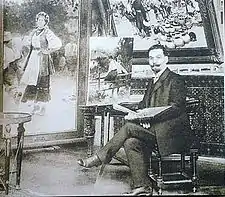
In 1884, due to poor health (possibly tuberculosis) and financial difficulties, he returned to Kiev, where he found work as a drawing teacher at a private school.[16] He moved to the Kiev Polytechnic Institute in 1901, when the school went out of business, and remained there for the rest of his life. After 1906, he also taught at the new Kiev Art School, which he helped organize.[14] Kazimir Malevich was one of his most notable students.
In 1897, he participated in decorating St Vladimir's Cathedral and was awarded the Order of Saint Anne for his work there. He became a full member of the Peredvizhniki in 1899 and was named an "Academician" in 1904.[14] He also exhibited widely; winning a gold medal at the Salon in 1909 for his painting Gopak. It currently hangs in the Louvre.[16]
Later, he temporarily fell out of favor with the Peredvizhniki when one of his paintings, "Going Home" was used (apparently without his permission) by the Shustov Vodka Company to promote their spotykach (a type of horilka). He was accused of having become "corrupted" and was forced to sue the company to have the image removed.[15]
He died in 1912 after a short, serious illness. He was buried at the Lukyanivka Cemetery. His posthumous exhibition at the Academy of Arts, which took place in early 1913, featured 184 paintings, 419 sketches and 112 pencil drawings. In 1959, a street was named after him and, in 1997, a museum devoted to him was opened in Malyutyanka, a village where he painted during the summers, in the Kyiv-Sviatoshyn Raion. Several of his works have alternate versions, often painted years apart.
Selected paintings
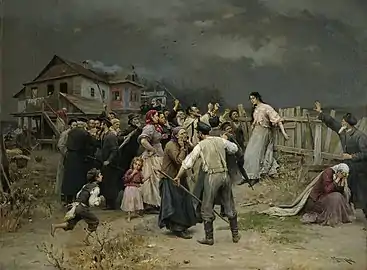 A Victim of Fanaticism
A Victim of Fanaticism A Fabric Trading Woman
A Fabric Trading Woman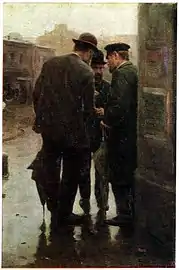 A Conversation
A Conversation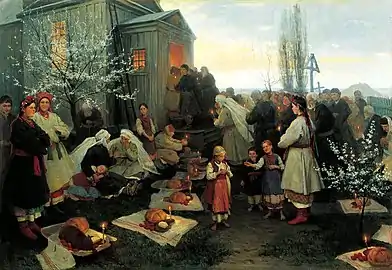 Easter Matins
Easter Matins Matchmakers
Matchmakers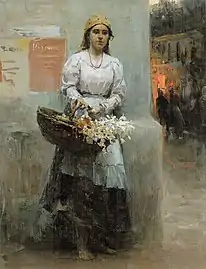 Flower Girl
Flower Girl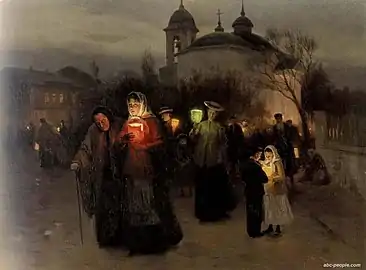
 Ukrainian Wedding
Ukrainian Wedding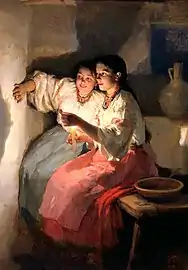 Yuletide
Yuletide
Fortune Tellers
References
- "Pymonenko, Mykola". Internet Encyclopedia of Ukraine. Retrieved 2021-01-20.
- Beletsky, P.; Vladich, L. (1976). Ukrainian Painting. Translated by Pamfilov, Yu. Leningrad: Aurora Art Publishers. p. 9.
- "Mykola Pymonenko – the Artist of Choice". Sova Books. 2019-07-07. Retrieved 2020-11-18.
- "Pimonenko Mikola Kornilievich. On the 150th anniversary of his birth". Igor Sikorsky Kyiv Polytechnic Institute. Retrieved 2021-01-20.
- "Mykola Pymonenko Painting Reproductions". Top of Art. Retrieved 2021-01-20.
- Konovalov, Ėduard; Коновалов, Эдуард. (2008). Slovarʹ russkikh khudozhnikov : Novyĭ polnyĭ biograficheskiĭ. Moscow: ĖKSMO. p. 386. ISBN 978-5-699-20636-0. OCLC 234387130.
Russo-Ukrainian painter (russko-ukrainskii zhivopisets)
- Philip Hook, Mark Poltimore. Popular 19th century painting: a dictionary of European genre painters. Antique Collectors' Club, 1986. P. 229.
- Sobko N. P.: Lexikon of Russian painters, Saint Petersburg: M.M. Stasyulevich, 1893-1899 (in Russian).
- Nikolai Pimonenko (Encyclopedia of Russian painting)
- Kovtun J.: Russische Avantgarde, London 2013 (in German, translated from the Russian).
- Konovalov E.: Lexikon of Russian Painters. Moscow 2008, P. 386 (in Russian). Note: in this book, it says Pimonenko is Russian-Ukrainian.
- Entry for Mykola Pymonenko at Encyclopedia of Ukraine. [Accessed 18 Nov. 2020].
- Pimonenko Mikola Kornilievich. On the 150th anniversary of his birth, Igor Sikorsky Kyiv Polytechnic Institute
- Brief biography @ RusArtNet.
- Biography and appreciation @ Otrok.
- Brief biography @ Russian paintings.
Further reading
- Затенацкий Я. П. (1955). Николай Корнилович Пимоненко: жизнь и творчество, 1862-1912 (Nikolay Kornilovich Pimonenko: Life and Work, 1862-1912. Киев / Kiev: Академия наук Украинской ССР; Институт искусствоведения, фольклора и этнографии (Ukrainian SSR Science Academy; Institute of Arts, Folklore and Ethnography). OCLC 652334680., in Russian.
- I.V. Ogievska, Микола Пимоненко: альбом, Kyiv: Mystetstvo, 2013 ISBN 978-966-577-109-8, book in Ukrainian and English.
- Volodymyr Orlovskyi (text), Микола Пимоненко (Mykola Pymonenko), images compiled by Olga Zhbankova, edited by Alexander Klimchuk. National Art Museum of Ukraine (Національний Художній Музей України), and Khmelnitsky: Galereya, 2004 ISBN 966-8834-05-4, in Ukrainian.
- Boris Chyp, O.G. Oganesyan, Микола Пимоненко: біографічний роман (Mykola Pymonenko: biographical novel), Vol.59 of "Celebrated Names", Kyiv: Molod' (Youth Publishing), 1983, in Ukrainian.
External links
| Wikimedia Commons has media related to Mykola Pymonenko. |
- Mykola Pymonenko @ WikiArt - you can see some of his paintings here (website in English). Note the box on right that may have held a product name.
- Entry for Mykola Pymonenko at Encyclopedia of Ukraine (website in English).
- Search results for Pymonenko M.K. @ Kyiv Polytechnic Institute (KPI), (website in Ukrainian).